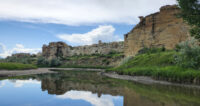Mountain pine beetle research gets funding boost
By Alejandra Pulido-Guzman - Lethbridge Herald on February 16, 2022.
 Submitted photo
University of Lethbridge post-doctoral fellow Zhouxin Xi uses a laser scanner in Jasper National Park during the summer of 2021 to measure forest branches in trees killed by mountain pine beetle.
Submitted photo
University of Lethbridge post-doctoral fellow Zhouxin Xi uses a laser scanner in Jasper National Park during the summer of 2021 to measure forest branches in trees killed by mountain pine beetle.LETHBRIDGE HERALDapulido@lethbridgeherald.com
A research study at the University of Lethbridge is benefiting from a Mitacs Accelerate grant in partnership with Foothills Research Institute worth $180,000.
University of Lethbridge professors in the Department of Geography and Environment Laura Chasmer and Chris Hopkinson, have partnered with FRI Research, an Alberta-based, not-for-profit organization, to collaborate on the creation of a 3-D map to illustrate the distribution of fire fuels in Jasper National Park.
“Mitacs is a really great opportunity for students as it allows them to do an internship with an industry partner. This is really important because it demonstrates that our work, our research is valuable to the broader community and to industry,” said Chasmer, lead researcher.
Two interns, Zhouxin Xi, a post-doctoral fellow, and Saeid Parsian, a graduate student, will work on the project for two years, with half of their stipend being paid by Mitacs.
The study is called Development of Terrestrial and Airborne LiDAR (Light Detection and Ranging) methods for understanding fire fuels associated with mountain pine beetle in the eastern slopes of Alberta.
“What we’re interested in doing is looking at how mountain pine beetles are impacting forests on the eastern slopes, predominantly in Jasper National Park. But we’re also interested in knowing when mountain pine beetles go through and they decimate these forests, how that results in an accumulation of fuels for wild-land fire,” said Chasmer, lead researcher.
She said the main premise of this study is not just for understanding mountain pine beetles, but rather for understanding how dead trees contribute to wildfires.
“When a mountain pine beetle attacks a tree, what happens is that tree will slowly shut off the movement of moisture through the tree, and so the tree basically dies,” said Chasmer.
She explained there is a chain reaction that is set from there, since fire loves dried trees and branches, which they consider ‘fuels’.
“Eventually these trees fall over, so it is a considerable risk when you have a forest that’s being completely decimated by mountain pine beetles such as what we’re seeing in Jasper,” said Chasmer.
She said they are really interested in using state of the art technologies such as terrestrial laser scanning and airborne laser scanning to identify where the fuels are accumulating in the landscape, and how they can reduce those fuels to reduce the hazard and risk for the town of Jasper.
Their research has included surveys all along the eastern slopes, including Waterton Lakes, the Castle Mountain area and Banff and they have partnered with Alberta Environment and Parks, Natural Sciences and Engineering Research Council (NSERC), Canada Wildfire, Western Economic Diversification Canada, Aries Aviation International and Teledyne Optech.
“This is a really fantastic opportunity for the students because it gives them all kinds of networking abilities,” said Chasmer.
Chasmer said that another great opportunity for students happened last summer while conducting some field work, as The Nature of Things documentary crew put a documentary together on the work they are doing called Ice and Fire: Tracking Canada’s Climate Crisis.
The documentary can be viewed at https://www.cbc.ca/natureofthings/episodes/ice-and-fire-tracking-canadas-climate-crisis
Follow @APulidoHerald on Twitter
4-3




